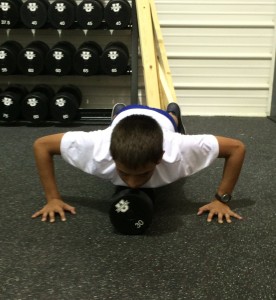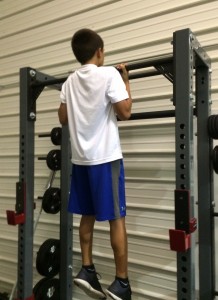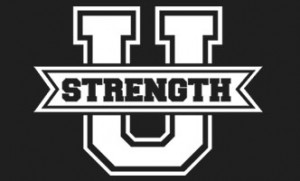BY: JC Moreau, Founder/Director of Sports Performance, Strength U
 I often hear the question from parents “when should my child begin strength training?” and my answer is typically pretty much the same. It depends on several variables, what type of “strength” training are you considering, who will be instructing it, what is your child’s athletic background and finally, what are your goals? Since most forms of gymnastics can be considered “strength” training the answer may be, as soon as you can walk. However, as it pertains to more traditional weight training with resistance (bands, DBs, barbells, sand bags etc…) there are a sleuth of other considerations to consider before coming to a definitive conclusion in response to this question. We work with several 10 year olds, but I know that what we do can benefit younger children as long as the programming is administered correctly.
I often hear the question from parents “when should my child begin strength training?” and my answer is typically pretty much the same. It depends on several variables, what type of “strength” training are you considering, who will be instructing it, what is your child’s athletic background and finally, what are your goals? Since most forms of gymnastics can be considered “strength” training the answer may be, as soon as you can walk. However, as it pertains to more traditional weight training with resistance (bands, DBs, barbells, sand bags etc…) there are a sleuth of other considerations to consider before coming to a definitive conclusion in response to this question. We work with several 10 year olds, but I know that what we do can benefit younger children as long as the programming is administered correctly.
However, the purpose of this article is to share some findings from the Australian Institute for Sport, which is arguably the world’s leader in the scientific study of athletic development, sports science, performance, injury prevention and technology.
In Coach Narelle Sibte’s report titled Weight Training- Pre-Adolescent Strength Training – Just Do It!, he explores the topics of youth resistance or weight training and it’s impact on the development of youth athletes. For years several myths have existed in regards to strength training and children, such as the potential negative impact on growth, an increase in the chance of injury or even that it is not possible for youth athletes to gain strength because of their hormonal makeup. It is important to note the author is referring to safe, movement based strength training, which must be led by a credentialed and experienced coached in a safe and conducive environment.
The article’s conclusions were that as follows:
-The majority of studies conducted over the last 25 years show that pre-teens who follow an appropriate training program demonstrated strength gains between 13-30% over an 8-12 week period.
-Strength increases twofold between the ages of 7 and 12 years old. Some may argue that failure to start resistance training before 16 may be detrimental to an athlete’s playing longevity.
-In initial stages of training, girls have potential to improve more than boys, as generally speaking, they start from a lower status.
-Gains from strength training for preadolescents are generally attributed to the nervous system and motor learning, rather than hormones.
-Pre-teens make similar relative gains in strength compared to later stages of development, but usually demonstrate smaller absolute strength increases following strength training.
When these finding were examined further it was clear that there are implications for injury prevention and performance enhancement rates in youth athletes. Common overuse injuries such as tendonitis and Osgood-Schlatter can result from poor flexibility, muscle-tendon mismatch and other movement and strength imbalance issues that proper strength training may be able to correct. Finally, the bone stress induced by resistance training may encourage bone growth through the various ways it encourages bone modelling. It is safe to say that this article and its supporting research demonstrate that strength training is not only beneficial for pre-adolescent athletes, but that it may actually be harmful to NOT be involved in some form of strength/weight training.
The next question logically should be, what is correct “strength/weight training”, and there are no shortage of opinions out there, however that is likely another subject altogether! We will lay out a sound approach to strength training for anyone regardless of age. First, the emphasis must always be placed on movement above all else. It is imperative to teach young athletes and they should be able to perfectly perform more complex, full-body movements, such as squats and lunges, with their body weight before an additional load is prescribed. Once technique and movement can be properly exhibited then the first basic principal of a sound strength training program to be explored is progressive overload.
Progressive overload simply refers to the continual addition of stress through either heavier weights, additional sets and/or reps (volume), training frequency or a more challenging tempo (the speed of each movement). In my good friend Cal Dietz’s training manual, Triphasic Training, he goes into great depth explaining why “stress” is king of all training variables. He is absolutely correct (and proves it is his nearly 600 page epic work), but it is not as simple as more is better. As a general rule new trainees do not want to add more than 5-10% in weight or volume each week, and must be very careful in regards to monitoring increases in frequency as well. It is interesting to note that certain research indicates that it is training intensity is the second most important variable to consider after progressive overload parameters have been established.
This research suggests that moderate intensities (65-75% 1RM or 10-15 reps) be used as a general guideline, and that max effort or “max out” lifts should be avoided! The rep range listed above has proven to provide enough stimulus to elicit strength gains, with the additional benefit of providing additional “practice” performing each movement. Like any other movement or skill we improve and become more comfortable with something as we get more reps and more practice and training with weights is no different than swinging a golf club in this regard. If the young athlete is doing 36 reps of squats in a session ( 3 sets of 12 repetitions) versus 15 (3 sets of 5 repetitions), it stands to reason that the neuro-muscular adaptation process required to perform a movement perfectly time after time will take place sooner.
A final area that must not be overlooked when designing a strength program for children is recovery. This may appear obvious, but we often take on the attitude that pre-teens cannot do too much and that kids are meant to play hard and often. However, with so many kids playing multiple sports and for multiple teams it is critical to find out what all of the other commitments are (athletically and otherwise). When we are introducing strength training to a young athlete it is to improve performance and decrease the likelihood of injury. Ignoring recovery could lead to the opposite, overuse or chronic injuries. One final note on recovery is that it also has everything to do with lifestyle, sleep, nutrition, hydration, and other more advanced regeneration techniques. It is never too soon to begin educating young athletes and their families on the importance of these, and how much they will impact the long term athletic development of their young athlete.
In summary, recent research shows us that strength or resistance training is beneficial for pre-teen athletes for a variety of reasons. Gains in strength, coordination, bone density and improvements in performance appear to be joined by a reduction in the rate of injury and more, among those participating in well designed and instructed strength training programs. We believe that movement in king and that each athlete must be able to perform various movements without obstruction before introducing a load (weight) to the movement. When this philosophy is observed it is safe to say that research shows us that weight training is beneficial, both long and short term, for pre-adolescent athletes.
Please send comments and inquiries to jc@TheStrengthU.com or visit TheStrengthU.com


